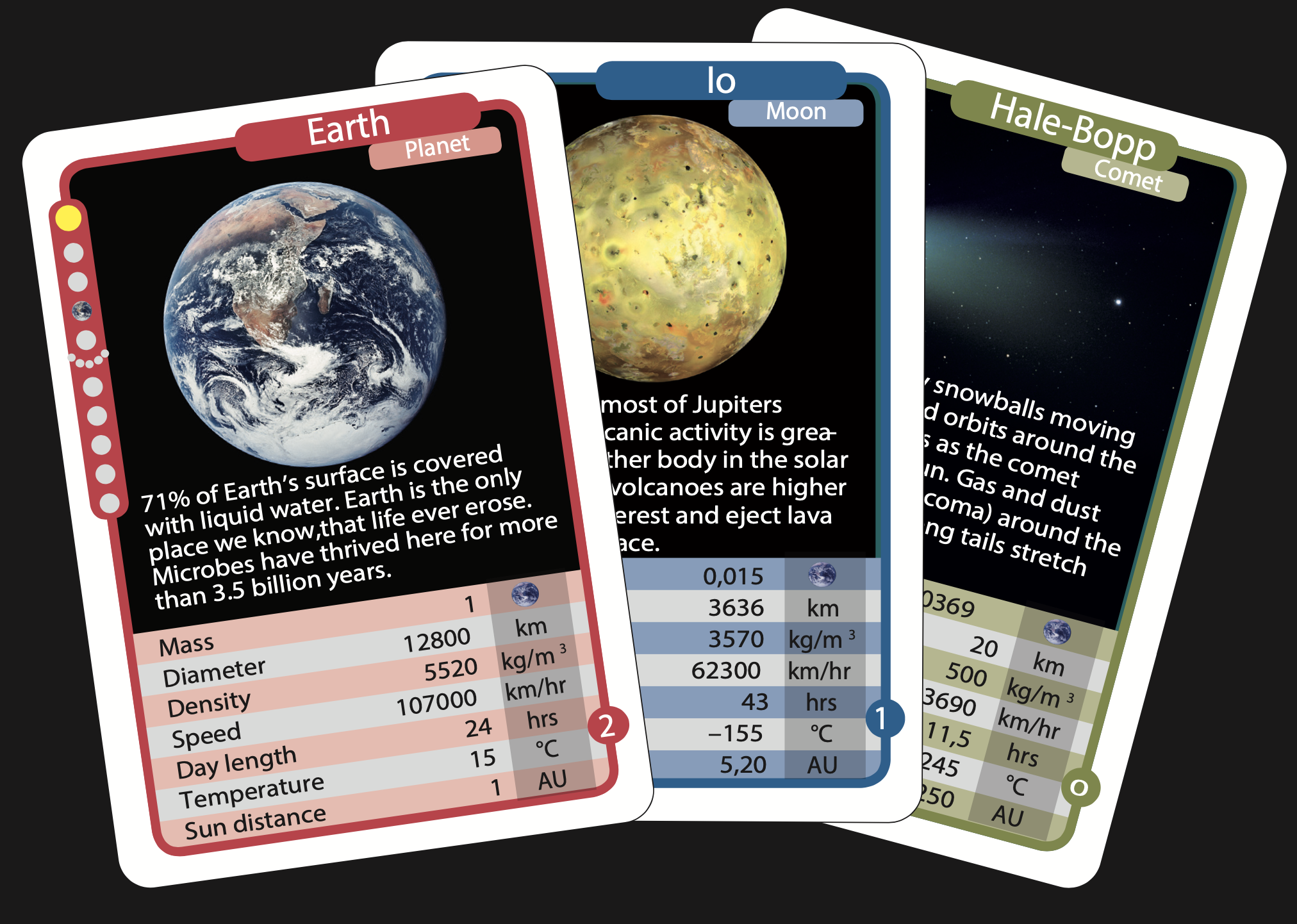Our games – Play & Learn
We visualize the invisible things that we talk About with fun game play


Our Games
Planetcards
PlanetCards invites players on an interstellar journey through the cosmos, where they can explore the wonders of our solar system and beyond. With stunning visuals and captivating gameplay, PlanetCards brings astronomy and planetary science to life in a fun and interactive way.
Whether building the solar system, engaging in the Battle of the Clodes, or playing a round of Rummy, PlanetCards offers something for everyone, from casual stargazers to aspiring astronomers. Get ready to embark on an astronomical adventure like no other with PlanetCards!
Planetcards
Rules To Play The Games
PlanetCards offers a variety of exciting games that are not only fun but also educational. Below, you’ll find the rules for each game to help you get started on your cosmic journey.
In the thrilling Battle of the Clodes, players compete to conquer planets and establish dominance in the galaxy. Utilize strategic thinking and knowledge about the solar system to outwit your opponents and claim victory.
Rules
Blend the cards and distribute them so that all players have a stack of equal size. Each player holds his/her stack of cards in the hand, so that only he/she can see the face of one card.
The youngest player starts the game, calling a category and a value, for example: “Temperature, 137 degrees!”. All players put down their uppermost card on the table face up. The player with the highest value wins all the cards on the table. The winner puts the cards at the bottom of his/her stack, and calls a category for the next round.
There are seven categories: mass, diameter, density, speed, day length, temperature, and sun distance. The highest value within a category always wins.
A battle will emerge if two or more players laid down cards with the same highest value. A battle proceeds when each involved player put down the next two cards face down and the third card face up. The player with the highest value on the third card wins all the cards in the battle.
The game continues until one player have lost all his/her cards. The winner is the one with the largest stack of cards, when the game is over.
Step into the shoes of a cosmic architect in Build the Solar System, where players embark on a mission to construct our very own celestial neighborhood. Learn about the planets, moons, asteroids and comets orbiting our own star: the Sun.
Preparations
This game requires a large table. Blend the cards. Each player is given three cards. The rest of the cards are put in one pile with the backside up.
Rules
The purpose of the game is to build the solar system. The planets constitute the backbone of the game, one beside the other from left to right. The moons are placed up-down, perpendicular to the planet row. The youngest player starts the game. In each turn, he/she draws one card from the pile and put down one card on the table. Then, the game continues to the next player (in clockwise direction). The player examines whether he/she has a matching card. A card matches if a neighbor is already on the table. Check the illustration on the left side of each card or the infocard to see the order of planets in the solar system. Here are some examples:
• Earth matches to Mars because they are adjacent planets.
• Titan matches Saturn because Titan is one of Saturn’s moons.
• Io matches Europa because they are both Jupiter moons.
• Kleopatra matches Mathilde because they are both asteroids.
• Comets are wild cards and can be laid instead of any other card.
• The Sun counts as a planet and matches Mercury.
• Ceres counts as a planet and matches between Mars and Jupiter.
• Pluto counts as a planet and matches Neptune.
You may not:
• Put down a card if none of its neighbors are on the table.
• Put down two moons belonging to neighboring planets.
For example, you can not match one of Jupiter’s moons to one of Saturn’s moons.
If a player cannot put down a card, he/she must pass and draw a card from the pile. Then, the turn continues to the next player. The winner is the one who manage to put down all cards from his/her hand.
Join in the cosmic card game craze with PlanetCards’ rendition of the classic game, Rummy. Put your strategic skills to the test as you collect sets and runs of cards representing astronomical phenomena.
Preparations
Blend the cards. Give each player 6 cards. Stack the rest in one pile face down. Take the uppermost card and place it face up next to the pile.
Rules
1. The youngest player starts by picking up the uppermost card from either one of the two piles.
2. The player checks to see if three or more cards on the hand fit together. Cards that fit include:
• 3 consecutive planets. For example: Venus, Earth, and Mars.
• 1 planet and 2 of its moons. For example: Saturn, Titan, and Mimas.
• 3 moons belonging to the same planet. For example: Io, Europa, and Callisto
• 3 asteroids. For example: Ida, Eros and Vesta
3. If the player has three or more cards that fit, then he/she can put them down on the table in his/her turn.
4. The player end his/her turn by putting down one card from the hand to the pile of upward facing cards.
5. The turn goes on and the game continues until one player no longer has any cards on his/her hand.
Note: In the illustration on the left side of each card, you can see the order of planets and where the card fits in the solar system.
Special rules
• You may put down cards one at a time to the cards that you already put down on the table. You may not add to other players’ cards.
• Instead of picking up one card at a time, a player can take the entire pile of face-up cards on the table. If the player cannot put down at least three fit cards, then he/she will be penalized with ÷10 points.
• The comets (Halley’s comet, Hale Bopp, Tempel 1, and Shoemaker Levy 9) are wild cards and can replace any other card.
Points
The sum of points are counted at the end of the round. Points are shown in the lower right corner on each card. The player gains points for each card that he/she has played on the table and looses (subtracts) points for each card ultimately on the hand. The winner is the player who first manage 50 points.


Where to buy PlanetCards
Ready to embark on your scientific adventure? Purchase your own set of PlanetCards today and start exploring the wonders of the universe! Click here to visit our buy page and get your hands on these captivating educational games.


Our Games
MicrobeCards
MicrobeCards is an exciting and educational game that plunges players into the fascinating world of microbiology. Designed to be both entertaining and informative, MicrobeCards introduces players to the diverse and often mysterious realm of microorganisms.
Through gameplay, players embark on microbial adventures, learning about different types of microbes, their habitats, and their roles in various ecosystems. Whether battling in MicrobeWars or exploring symbiotic relationships in Symbiosis, MicrobeCards offers a unique and engaging way to discover the hidden world of microbes.
Microbecards
Rules To Play The Games
MicrobeCards offers a range of engaging games designed to educate and entertain players about the fascinating world of microbiology. Below, you’ll find the rules for each game to help you dive into the microbial realm.
Enter the microscopic battlefield in Domain, where players command armies of microorganisms in an epic struggle for dominance.
From 8 years. 3-5 players
Rules
The game is about getting rid of your cards first. The first to get rid of her/his cards is called President, while the last one is called Scum. In the next game, the Scum must exchange her/his best card (virus) face down with the president’s worst card.
The game:
Shuffle the MicrobeCards and deal them into piles so that all players have an equal pile. Each player holds their cards in their hand so that you can see all your cards without others seeing them. The youngest player starts. He/she places one, two or three cards belonging to the same domain (bacteria, archaea or eukaryotes). After this, the game goes clockwise. The next player can either throw the same number of cards within the selected category or pass. The round is won by the person who passes last. However, a player can also choose to lay down one virus card that acts as a joker and clears the table. With this, the player immediately gets played in the next round.
Variation: The game can be expanded so that you can only place cards with at least the same energy as already placed on the table. That is a microbe with energy 16 ATP can be put on 8 ATP, but not vice versa. If several cards are placed at a time, the lowest energy counts.
Stay tuned for Symbiosis, the upcoming addition to the MicrobeCards collection. In this eagerly anticipated game, players will delve into the intricate relationships between microorganisms and their hosts.

The game has been produced in Danish for Videnskabsklubben and you can get them there. It is currently not available in shops elsewhere.
